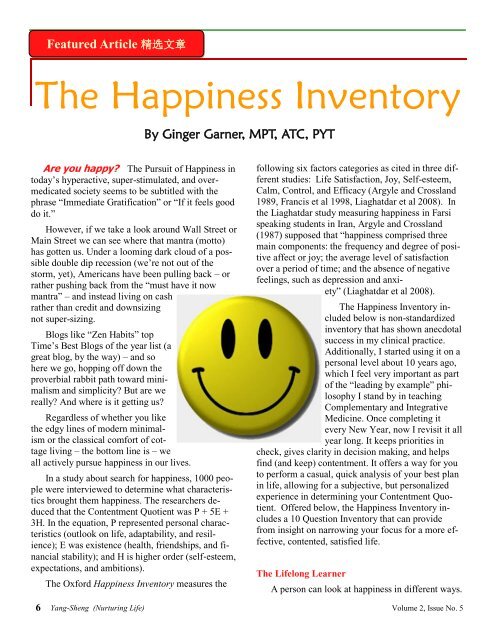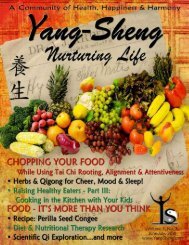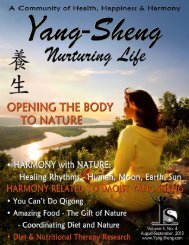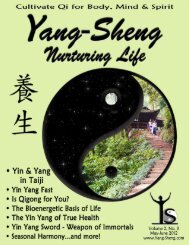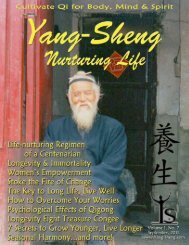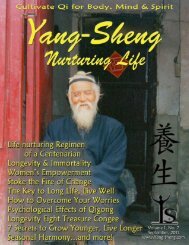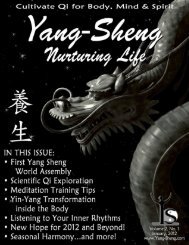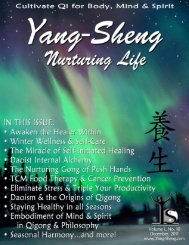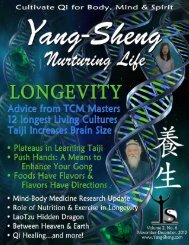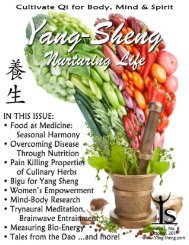Download - Yang-Sheng
Download - Yang-Sheng
Download - Yang-Sheng
You also want an ePaper? Increase the reach of your titles
YUMPU automatically turns print PDFs into web optimized ePapers that Google loves.
Featured Article 精 选 文 章<br />
The Happiness Inventory<br />
By Ginger Garner, MPT, ATC, PYT<br />
Are you happy? The Pursuit of Happiness in<br />
today’s hyperactive, super-stimulated, and overmedicated<br />
society seems to be subtitled with the<br />
phrase “Immediate Gratification” or “If it feels good<br />
do it.”<br />
However, if we take a look around Wall Street or<br />
Main Street we can see where that mantra (motto)<br />
has gotten us. Under a looming dark cloud of a possible<br />
double dip recession (we’re not out of the<br />
storm, yet), Americans have been pulling back – or<br />
rather pushing back from the “must have it now<br />
mantra” – and instead living on cash<br />
rather than credit and downsizing<br />
not super-sizing.<br />
Blogs like “Zen Habits” top<br />
Time’s Best Blogs of the year list (a<br />
great blog, by the way) – and so<br />
here we go, hopping off down the<br />
proverbial rabbit path toward minimalism<br />
and simplicity? But are we<br />
really? And where is it getting us?<br />
Regardless of whether you like<br />
the edgy lines of modern minimalism<br />
or the classical comfort of cottage<br />
living – the bottom line is – we<br />
all actively pursue happiness in our lives.<br />
In a study about search for happiness, 1000 people<br />
were interviewed to determine what characteristics<br />
brought them happiness. The researchers deduced<br />
that the Contentment Quotient was P + 5E +<br />
3H. In the equation, P represented personal characteristics<br />
(outlook on life, adaptability, and resilience);<br />
E was existence (health, friendships, and financial<br />
stability); and H is higher order (self‐esteem,<br />
expectations, and ambitions).<br />
The Oxford Happiness Inventory measures the<br />
following six factors categories as cited in three different<br />
studies: Life Satisfaction, Joy, Self-esteem,<br />
Calm, Control, and Efficacy (Argyle and Crossland<br />
1989, Francis et al 1998, Liaghatdar et al 2008). In<br />
the Liaghatdar study measuring happiness in Farsi<br />
speaking students in Iran, Argyle and Crossland<br />
(1987) supposed that “happiness comprised three<br />
main components: the frequency and degree of positive<br />
affect or joy; the average level of satisfaction<br />
over a period of time; and the absence of negative<br />
feelings, such as depression and anxiety”<br />
(Liaghatdar et al 2008).<br />
The Happiness Inventory included<br />
below is non-standardized<br />
inventory that has shown anecdotal<br />
success in my clinical practice.<br />
Additionally, I started using it on a<br />
personal level about 10 years ago,<br />
which I feel very important as part<br />
of the “leading by example” philosophy<br />
I stand by in teaching<br />
Complementary and Integrative<br />
Medicine. Once completing it<br />
every New Year, now I revisit it all<br />
year long. It keeps priorities in<br />
check, gives clarity in decision making, and helps<br />
find (and keep) contentment. It offers a way for you<br />
to perform a casual, quick analysis of your best plan<br />
in life, allowing for a subjective, but personalized<br />
experience in determining your Contentment Quotient.<br />
Offered below, the Happiness Inventory includes<br />
a 10 Question Inventory that can provide<br />
from insight on narrowing your focus for a more effective,<br />
contented, satisfied life.<br />
The Lifelong Learner<br />
A person can look at happiness in different ways.<br />
6 <strong>Yang</strong>-<strong>Sheng</strong> (Nurturing Life) Volume 2, Issue No. 5


